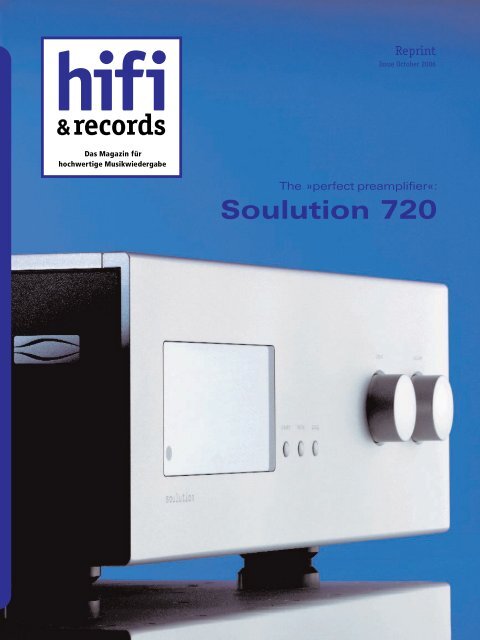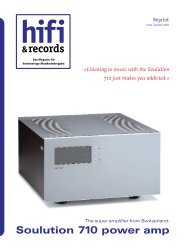Soulution 720 - Axiss Audio
Soulution 720 - Axiss Audio
Soulution 720 - Axiss Audio
You also want an ePaper? Increase the reach of your titles
YUMPU automatically turns print PDFs into web optimized ePapers that Google loves.
SD_<strong>Soulution</strong><strong>720</strong> engl. 05.12.2006 9:28 Uhr Seite 1<br />
hifi<br />
& records<br />
Das Magazin für<br />
hochwertige Musikwiedergabe<br />
Reprint<br />
Issue October 2006<br />
The »perfect preamplifier«:<br />
<strong>Soulution</strong> <strong>720</strong>
SD_<strong>Soulution</strong><strong>720</strong> engl. 05.12.2006 9:28 Uhr Seite 14
SD_<strong>Soulution</strong><strong>720</strong> engl. 05.12.2006 9:28 Uhr Seite 15<br />
Having outed myself in issue 1/2006 as a junky who has<br />
totally fallen for the addictive <strong>Soulution</strong> 710, I had, as a<br />
precaution, reported absent for further amplifier reviews.<br />
But I had promised to report back again as soon as the <strong>Soulution</strong><br />
<strong>720</strong> preamp could be delivered – provided it plays in the same<br />
league as the power amp.<br />
And this is what has happened in the meantime: the amp models<br />
710 and <strong>720</strong> have both received the renowned Red Dot Award<br />
2006 of the Design Zentrum Nordrhein-Westfalen in the audio category<br />
and are currently nominated for another highly respected<br />
prize, i.e. the Design Award of the Federal Republic of Germany.<br />
Above all the Red Dot jury had appreciated the fact that, owing to<br />
their straightforward design, the <strong>Soulution</strong> twins fit in harmonically<br />
into various home styles – something which is rarely associated<br />
with highend devices, notably in the weight division of the<br />
710 power amp. A marvellous, well-deserved success for the Swiss<br />
makers of these amplifiers.<br />
And something else has happened which is especially important<br />
to me from a purely egocentric point of view: in July 2006, I finally<br />
got the <strong>Soulution</strong> <strong>720</strong> preamp for a review and since then it has<br />
demonstrated every day that it’s not only one, but the perfect match<br />
for the 710 power amp on whose drip I am still hanging. Before I<br />
bestow my personal sound award upon the <strong>720</strong>, we should busy<br />
ourselves a bit more thoroughly with this preamp. Good thing that<br />
it weighs »only« 30 kilograms. True, there are others who build fullgrown<br />
power amps of this weight, but everything in the world is<br />
relative. And in relation to the <strong>Soulution</strong> 710 which requires lifting<br />
tremendous 80 kilograms in its latest version, the weight of the <strong>720</strong><br />
Review: <strong>Soulution</strong> <strong>720</strong> preamplifier<br />
Another addictive amplifier from Switzerland:<br />
The <strong>Soulution</strong> <strong>720</strong> preamp celebrates music on<br />
the very highest level.<br />
is »adequate«. Prior to making the crash test you<br />
should definitely check if your rack can handle the<br />
<strong>Soulution</strong>s’ combined combat load of 110 kilograms.<br />
Irrespective of any weight problems which may arise,<br />
the <strong>Soulution</strong> ensemble 710 and <strong>720</strong> presents a<br />
harmonic entity owing to its clear-cut design language<br />
even if the two amps are stacked directly.<br />
Like every full-fledged preamp the <strong>720</strong> also controls<br />
a whole regiment of sources, preparing their<br />
partly delicate signals for the subsequent power<br />
amp and controlling their levels. In its administrative<br />
function the <strong>Soulution</strong> takes care of two balanced<br />
stereo signals, three unbalanced stereo line signals<br />
plus one stereo MC signal. Optionally the<br />
preamp is available as <strong>Soulution</strong> 721 with an additional<br />
unbalanced line input instead of the MC section.<br />
Independent of the source you’re listening to,<br />
via Tape Out any of the connected sources can be<br />
tapped for recording. The preamp’s output signal is<br />
fed to both a balanced and unbalanced pair of<br />
sockets. Thus, if required, a subwoofer can be hooked<br />
up easily without an adapter.<br />
Via bus cable the preamp communicates with<br />
other <strong>Soulution</strong> components, hence so far only with<br />
the power amp which needn’t be turned on and off<br />
separately then. Volume and input sources are selected<br />
with the two large rotary knobs on the almost<br />
naked front panel or alternatively via the remote<br />
control. Although not made of metal (as preferred by<br />
high end fans) but of banal plastic, it’s a true hand<br />
charmer and at least ergonomically one of the best<br />
I’ve ever seen.<br />
Mains, mute and program buttons are likewise located<br />
on the front panel and the remote. What can<br />
be programmed at all on the analogue <strong>Soulution</strong><br />
<strong>720</strong>? Everything which makes the use of a preamp<br />
comfortable and adequate. Thus you can determine<br />
which input shall be active after turn-on, which<br />
Hard Drug
SD_<strong>Soulution</strong><strong>720</strong> engl. 05.12.2006 9:28 Uhr Seite 16<br />
input shall be recorded from, the initial<br />
volume level, the amount of level reduction<br />
by the mute function, the maximum<br />
output level, the balance between the stereo<br />
channels, the names of the connected<br />
sources, the operating bandwidth of<br />
the <strong>720</strong>, the individual level settings for<br />
each input, the gain factor of the phono<br />
stage, the display brightness and finally<br />
if the sub low cut is needed.<br />
While audiophile circles tend to rate<br />
amplifiers with balanced circuit designs<br />
superior to unbalanced ones, they often<br />
overlook the fact that such a balanced<br />
layout inevitably requires twice as many<br />
components. The <strong>Soulution</strong> designers<br />
love to have as few components as possible<br />
in the signal path and therefore prefer<br />
sending the signals on a single-lane<br />
path through the circuit. Indeed very<br />
useful, however, is the consistent mono<br />
layout of the <strong>720</strong>’s stereo<br />
channels based on separate circuit boards,<br />
as this produces a better S/N ratio<br />
and hence a better sound. But contrary to<br />
the pure theory of a consistent dual-mono<br />
layout, these are fed from a common<br />
mains section – of course, the digital<br />
control of the <strong>720</strong> has a mains supply of<br />
its own. And this for a good reason: while<br />
conventional mains supplies have a<br />
considerable output resistance that becomes<br />
evident in load-induced voltage fluctuations<br />
(so it’s a good idea to use separate<br />
power supplies for each channel in<br />
order to gain technical and acoustic benefits<br />
from an amplifier’s mono design),<br />
the <strong>Soulution</strong> has only a single power<br />
supply which shows virtually no output<br />
resistance irrespective of any loads. Such<br />
a mains section is immune to load and<br />
hence ideally suited as a combined current<br />
source for both<br />
AMPLIFIERS<br />
amplifier paths – perfect preconditions<br />
for a clean and unrestrained signal flow.<br />
Imagine we are a signal bound to set<br />
off on a journey through the <strong>Soulution</strong><br />
<strong>720</strong>. The first thing we’ll meet is a highquality<br />
relay which presents no resistance<br />
worth mentioning. Signals from<br />
other connected sources will not bother<br />
us either, because their relays will block<br />
the hot conductor as well as the cold or<br />
ground conductor. Next we enter a buffer<br />
stage which ensures that the source<br />
we came from will not be loaded by the<br />
amplifier circuit we are just passing<br />
through. Before us lies an amplifying<br />
stage for the basic level settings so that<br />
we will not be louder or softer than other<br />
source signals. We will leave this stage<br />
either unaltered or boosted by 3, 6 or 9<br />
decibels.<br />
There is one more optional hurdle to<br />
cross: a bandwidth filter for cutting out<br />
HF interference, for example from<br />
impure digital sources. We will pass this<br />
filter either with the full bandwidth of 1<br />
MHz or get cut down to 200 kHz or, in<br />
the worst case, to a mere 20 kHz. Something<br />
which has gone unnoticed<br />
so far, but which is not inessential<br />
for the operating safety of<br />
the <strong>Soulution</strong> <strong>720</strong>: spurious DC
SD_<strong>Soulution</strong><strong>720</strong> engl. 05.12.2006 9:28 Uhr Seite 17<br />
components we may carry along will be<br />
detected and neutralized by a quick hookup<br />
of a high-grade Mundorf capacitor.<br />
Now the volume control lies before us<br />
in the form of an attenuation network.<br />
This bottleneck keeps up to 80 ultra-precise<br />
Vishay resistors on the go. When rotating<br />
the volume knob, no clicks are audible<br />
because the gaps in the signal flow<br />
caused by switching between the Vishays<br />
are artfully filled by an integrated conventional<br />
level control. Hence the signal<br />
finds a continuous path through the volume<br />
control without having to jump<br />
over deep ravines. And here we have already<br />
reached the output stage with its<br />
current capability of up to 3A and an extremely<br />
high upper bandwidth of 40<br />
MHz: this will give us the necessary momentum<br />
to run even through the most<br />
rebellious power amp connection cable<br />
with no losses. Sure enough, being the<br />
signal we saw quite some circuitry power<br />
flashing by left and right of our way<br />
through the <strong>Soulution</strong> <strong>720</strong>; yet in comparison<br />
we have passed a signal highway<br />
Each channel of the <strong>Soulution</strong> <strong>720</strong> has<br />
its own impressive circuit board (opposite<br />
left; the phono MC board is mounted<br />
on top). The dual-mono design (below)<br />
ensures optimum channel<br />
separation. Above right: noble Vishay<br />
resistors provide the volume control.<br />
at top speed – especially in the final spurt<br />
to the output stage on broad copper rails<br />
– with no stop worth mentioning. One<br />
can only wonder if the <strong>720</strong> is equally<br />
transparent for a listener in the opposite<br />
direction, i.e. towards the source.<br />
Why, yes! Maybe it was because our test<br />
specimen had already been burnt in, I<br />
don’t know – but it became obvious within<br />
the first few minutes (and while the<br />
<strong>Soulution</strong> <strong>720</strong> was still rather cool) where<br />
our journey would lead us: straight to<br />
audiophile paradise, department of ultimate<br />
hifi. What strikes the ear right<br />
away: escorted by the 710 power amp and<br />
the Revel F52s, one can virtually hear<br />
through the <strong>720</strong> preamp back to the<br />
source, be it digital like the dCS combination<br />
of Verdi / Purcell / Delius or analogue<br />
such as the Schröder-guided Clearaudio<br />
Goldfinger. Fine, finer, the finest.<br />
soulution<br />
nature of sound<br />
Highend <strong>Audio</strong> Equipment<br />
präzise um die feinsten<br />
Details abzubilden.<br />
schnell um allen Klängen<br />
mit Ruhe zu folgen.<br />
stabil um die Harmonie der<br />
Musik zu bewahren.<br />
stark um musikalische<br />
Ereignisse in ihrer<br />
Grösse darzustellen.<br />
soulution<br />
Spemot AG<br />
Industriestrasse 70<br />
CH - 4657 Dulliken<br />
Telefon +4162 2 85 30 40<br />
Telefax +4162 2 95 52 02<br />
www.soulution-audio.com
SD_<strong>Soulution</strong><strong>720</strong> engl. 05.12.2006 9:28 Uhr Seite 18<br />
AMPLIFIERS<br />
Lab-Report<br />
Frequency response: <strong>Soulution</strong> <strong>720</strong> dbr / Hz<br />
Harmonic Distortion: <strong>Soulution</strong> <strong>720</strong> %/Hz<br />
Noise: <strong>Soulution</strong> <strong>720</strong> dbr / Hz<br />
Preamplifier <strong>Soulution</strong> <strong>720</strong><br />
Gain factor 3,46 dB<br />
Max. output voltage 9,5 V<br />
Input impedance (1kHz) 96 kΩ<br />
Output impedance (1kHz)



